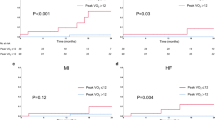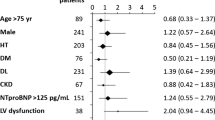Abstract
Background:
There are few data about predictors of cardiovascular mortality and rehospitalization rate in patients with left ventricular systolic dysfunction (LVSD) after myocardial revascularization and optimization of pharmacological treatment.
Patients and Methods:
1,346 consecutive patients with left ventricular ejection fraction (LVEF) < 45% (64 ± 10 years, 73% male, LVEF 36.3% ± 8%), who were referred for inpatient cardiac rehabilitation, were followed prospectively for 731 ± 215 days in a unicentric prospective longitudinal registry. Multivariate logistic regression Cox models were used to analyze demographic, echocardiographic and exercise variables in order to determine independent predictors of cardiovascular mortality and rehospitalization.
Results:
LVEF failed to show prognostic power (hazard ratio [HR] 0.99 [95% confidence interval, CI, 0.94–1.03]; p = not significant), whereas moderate to severe mitral regurgitation (HR, 5.71 [95% CI 1.75–18.6]; p = 0.004) and atrial fibrillation (HR 1.67 [95% CI 1.15–2.44]; p = 0.008) were associated with a poorer prognosis. In an optimized multivariate model, 6-min walk test (HR 0.93 [95% CI 0.86–1.00] per 50 m; p = 0.049) and symptom-limited maximum exercise capacity test (HR 0.83 [95% CI 0.76–0.91] per 10 W; p < 0.001) as well as female gender (HR 0.58 [95% CI 0.39–0.84]; p = 0.005) were strong predictors for reduced overall mortality.
Conclusion:
In patients with LVSD, independently of LVEF, traditional prognostic factors including atrial fibrillation or mitral regurgitation predict poorer survival, whereas symptom-limited exercise capacity and walking distance performed in 6-min walk test were highly predictive for a good prognosis.
Zusammenfassung
Hintergrund:
Bei revaskularisierten und medikamentös leitlinienorientiert therapierten Patienten mit linksventrikulärer systolischer Dysfunktion sind prognostische Parameter für kardiovaskuläre Mortalität und Rehospitalisierung unzureichend bekannt.
Patienten und Methodik:
1 346 konsekutive Patienten mit einer linksventrikulären Ejektionsfraktion (LVEF) < 45% (64 ± 10 Jahre, 73% männlich, LVEF 36,3% ± 8%) wurden im Rahmen einer kardiologischen Rehabilitation in einem unizentrischen prospektiven Register erfasst und 731 ± 215 Tage nachbeobachtet. In einer multivariaten Cox-Regressionsanalyse wurde der Einfluss demographischer, echokardiographischer und funktioneller Parameter auf die Endpunkte kardiovaskuläre Mortalität und Rehospitalisationsrate beurteilt.
Ergebnisse:
Die LVEF zeigte keinen signifikanten prognostischen Einfluss (Hazard-Ratio [HR] 0,99 [95%-Konfidenzintervall, CI, 0,94–1,03]; p = nicht signifikant), wohingegen das Vorliegen einer höhergradigen Mitralklappeninsuffizienz (HR 5,71 [95%-CI 1,75–18,6]; p = 0,004) und eines Vorhofflimmerns (HR 1,67 [95%-CI 1,15–2,44]; p = 0,008) mit einer schlechten Prognose assoziiert war. Im optimierten Gesamtmodell wiesen eine bessere körperliche Leistungsfähigkeit im 6-min-Gehtest (HR 0,93 [95%-CI 0,86–1,00] pro 50 m; p = 0,049) und in der symptomlimitierten Ergometrie (HR 0,83 [95%-CI 0,76–0,91] pro 10 W; p < 0,001) sowie weibliches Geschlecht (HR 0,58 [95% CI 0,39–0,84]; p = 0,005) die höchste Vorhersagekraft für eine reduzierte Gesamtmortalität auf.
Schlussfolgerung:
Traditionelle prognostische Risikofaktoren wie Vorhofflimmern oder eine höhergradige Mitralklappeninsuffizienz sind bei Patienten mit systolischer Linksherzinsuffizienz unabhängig von der linksventrikulären Ejektionsfraktion mit einer Steigerung der Mortalitätsrate assoziiert. Demgegenüber sind die maximale Leistungsfähigkeit in der Ergometrie und im 6-min-Gehtest positive Prädiktoren für die Langzeitprognose.
Similar content being viewed by others
References
Kerzner R, Gage BF, Freedland KE, et al. Predictors of mortality in younger and older patients with heart failure and preserved or reduced left ventricular ejection fraction. Am Heart J 2003;146:286–290.
Pitt B, Remme W, Zannad F, et al., Eplerenone Post-Acute Myocardial Infarction Heart Failure Efficacy and Survival Study Investigators. Eplerenone, a selective aldosterone blocker, in patients with left ventricular dysfunction after myocardial infarction. N Engl J Med 2003;348:1309–1321.
Young JB, Dunlap ME, Pfeffer MA, et al. Mortality and morbidity reduction with candesartan in patients with chronic heart failure and left ventricular systolic dysfunction: results of the CHARM low-left ventricular ejection fraction trials. Circulation 2004;110:2618–2626.
Zipes DP, Camm AJ, Borggrefe M, et al. ACC/AHA/ESC 2006 guidelines for management of patients with ventricular arrhythmias and the prevention of sudden cardiac death: a report of the American College of Cardiology/American Heart Association Task Force and the European Society of Cardiology Committee for Practice Guidelines Writing (Committee to Develop Guidelines for Management of Patients with Ventricular Arrhythmias and the Prevention of Sudden Cardiac Death). J Am Coll Cardiol 2006;48:247–346.
Stewart S, MacIntyre K, Hole DJ, et al. More “malignant” than cancer? Five-year survival following a first admission for heart failure. Eur J Heart Fail 2001;3:315–322.
Cygankiewicz I, Zareba W, Vazquez R, et al. Heart rate turbulence predicts all-cause mortality and sudden death in congestive heart failure patients. Heart Rhythm 2008;5:1095–1102.
de Sousa MR, Morillo CA, Rabelo FT, et al. Non-sustained ventricular tachycardia as a predictor of sudden cardiac death in patients with left ventricular dysfunction: a meta-analysis. Eur J Heart Fail 2008;10:1007–1014.
Laukkanen JA, Kurl S, Salonen R, et al. The predictive value of cardiorespiratory fitness for cardiovascular events in men with various risk profiles: a prospective population-based cohort study. Eur Heart J 2004;25:1428–1437.
Feigenbaum H. Echocardiographic evaluation of cardiac chambers. In: Bussy RK, ed. Echocardiography, 5th edn. Philadelphia: Lea & Febiger, 1994:138–140.
Guyatt GH, Sullivan MJ, Thompson PJ, et al. The 6-minute walk: a new measure of exercise capacity in patients with chronic heart failure. CMAJ 1985;132:919–923.
Remme WJ. The treatment of heart failure. Task Force of the Working Group on Heart Failure of the ESC. Eur Heart J 1997;18:736–753.
Molenberghs G, Kenward MG. Missing data in clinical studies. Chichester: Wiley, 2007.
Reibis R, Dovifat C, Dissmann R, et al. Implementation of evidence based therapy in patients with systolic heart failure from 1998–2000. Clin Res Cardiol 2006;95:154–156.
Corell P, Gustafsson F, Schou M, et al. Prevalence and prognostic significance of atrial fibrillation in outpatients with heart failure due to left ventricular systolic dysfunction. Eur J Heart Fail 2007;9:258–265.
Pocock SJ, Wang D, Pfeffer MA, et al. Predictors of mortality and morbidity in patients with chronic heart failure. Eur Heart J 2006;27:65–75.
Olsson LG, Swedberg K, Ducharme A, et al. Atrial fibrillation and risk of clinical events in chronic heart failure with and without left ventricular systolic dysfunction: results from the Candesartan in Heart failure-Assessment of Reduction in Mortality and morbidity (CHARM) program. J Am Coll Cardiol 2006;47:1997–2004.
Miyasaka Y, Barnes ME, Bailey KR, et al. Mortality trends in patients diagnosed with first atrial fibrillation: a 21-year community-based study. J Am Coll Cardiol 2007;49:986–992.
Amigoni M, Meris A, Thune JJ, et al. Mitral regurgitation in myocardial infarction complicated by heart failure, left ventricular dysfunction, or both: prognostic significance and relation to ventricular size and function. Eur Heart J 2007;28:326–333.
Hillis GS, Møller JE, Pellikka PA, et al. Prognostic significance of echocardiographically defined mitral regurgitation early after acute myocardial infarction. Am Heart J 2 2005;150:1268–1275.
Pastorius CA, Henry TD, Harris KM. Long-term outcomes of patients with mitral regurgitation undergoing percutaneous coronary intervention. Am J Cardiol 2007;100:1218–1223.
de Groote P, Lamblin N, Mouquet F, et al. No gender survival difference in a population of patients with chronic heart failure related to left ventricular systolic dysfunction and receiving optimal medical therapy. Arch Cardiovasc Dis 2008;101:242–248.
De Feo S, Opasich C. Comparison of the outcome in men and women with chronic heart failure. Ital Heart J 2003; 4:511–513.
Solomon SD, Anavekar N, Skali H, et al., Candesartan in Heart Failure Reduction in Mortality (CHARM) Investigators. Influence of ejection fraction on cardiovascular outcomes in a broad spectrum of heart failure patients. Circulation 2005;112:3738–3744.
Bittner V, Weiner DH, Yusuf S, et al. Prediction of mortality and morbidity with a 6-minute walk test in patients with left ventricular dysfunction. SOLVD Investigators. JAMA 1993;270:1702–1707.
Bittner V. Determining prognosis in congestive heart failure: role of the 6-minute walk test. Am Heart J 1999;138:593–596.
Passantino A, Lagioia R, Mastropasqua F, et al. Short-term change in distance walked in 6 min is an indicator of outcome in patients with chronic heart failure in clinical practice. J Am Coll Cardiol 2006;48:99–105.
Shah MR, Hasselblad V, Gheorghiade M, et al. Prognostic usefulness of the six-minute walk in patients with advanced congestive heart failure secondary to ischemic or nonischemic cardiomyopathy. Am J Cardiol 2001;88:987–993.
Roul G, Germain P, Bareiss P. Does the 6-minute walk test predict the prognosis in patients with NYHA class II or III chronic heart failure? Am Heart J 1998;136:449–445.
Arena R, Myers J, Aslam SS, et al. Peak VO2 and VE/VCO2 slope in patients with heart failure: a prognostic comparison. Am Heart J 2004;147:354–360.
Arena R, Myers J, Guazzi M. The clinical and research applications of aerobic capacity and ventilatory efficiency in heart failure: an evidence-based review. Heart Fail Rev 2008;13:245–269.
Guazzi M, Myers J, Abella J, et al. The added prognostic value of ventilatory efficiency to the Weber classification system in patients with heart failure. Int J Cardiol 2008;129:86–92.
Guazzi M, Myers J, Arena R. Cardiopulmonary exercise testing in the clinical and prognostic assessment of diastolic heart failure. J Am Coll Cardiol 2005;46:1883–1890.
Sharma R, Anker SD. The 6-minute walk test and prognosis in chronic heart failure — the available evidence. Eur Heart J 2001;22:445–448.
Cahalin LP, Mathier MA, Semigran MJ, et al. The six-minute walk test predicts peak oxygen uptake and survival in patients with advanced heart failure. Chest 1996;110:325–332.
Zugck C, Kruger C, Durr S, et al. Is the 6-minute walk test a reliable substitute for peak oxygen uptake in patients with dilated cardiomyopathy? Eur Heart J 2000;21:540–549.
Enright PL, McBurnie MA, Bittner V, et al. The 6-min walk test: a quick measure of functional status in elderly adults. Chest 2003;123:387–398.
Faggiano P, D'Aloia A, Gualeni A, et al. The 6 minute walking test in chronic heart failure: indications, interpretation and limitations from a review of the literature. Eur J Heart Fail 2004;6:687–691.
Hsich E, Gorodeski EZ, Starling RC et al. Importance of treadmill exercise time as an initial prognostic screening tool in patients with systolic left ventricular dysfunction. Circulation 2009;119:3189–3197.
Ingle L, Shelton RJ, Rigby AS, et al. The reproducibility and sensitivity of the 6-min walk test in elderly patients with chronic heart failure. Eur Heart J 2005;26:1742–1751.
Demers C, McKelvie RS, Negassa A, et al., RESOLVD Pilot Study Investigators. Reliability, validity, and responsiveness of the six-minute walk test in patients with heart failure. Am Heart J 2001;142:698–703.
Frankenstein L, Remppis A, Graham J, et al. Gender and age related predictive value of walk test in heart failure: do anthropometrics matter in clinical practice? Int J Cardiol 2008;127:331–336.
Myers J, Prakash M, Froelicher V, et al. Exercise capacity and mortality among men referred for exercise testing. N Engl J Med 2002;346:793–801.
Bleumink GS, Knetsch AM, Sturkenboom MC, et al. Quantifying the heart failure epidemic: prevalence, incidence rate, lifetime risk and prognosis of heart failure. The Rotterdam Study. Eur Heart J 2004;25:1614–1619.
Reibis R, Wegscheider K, Basinkevic V, et al. Steadiness of left ventricular ejection fraction after revascularization in patients post myocardial infarction: impact on primary prevention with implantable cardioverter/defibrillator (ICD). J Am Coll Cardiol 2007;49:16A.
Author information
Authors and Affiliations
Corresponding author
Rights and permissions
About this article
Cite this article
Reibis, R.K., Treszl, A., Wegscheider, K. et al. Exercise Capacity Is the Most Powerful Predictor of 2-Year Mortality in Patients with Left Ventricular Systolic Dysfunction. Herz 35, 104–110 (2010). https://doi.org/10.1007/s00059-010-3226-5
Received:
Accepted:
Published:
Issue Date:
DOI: https://doi.org/10.1007/s00059-010-3226-5
Key Words:
- Left ventricular systolic dysfunction
- Exercise capacity
- 6-min walk test
- Cardiovascular mortality
- Rehospitalization rate




